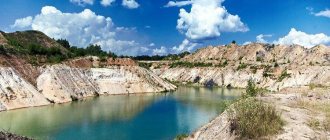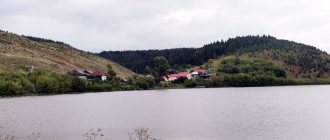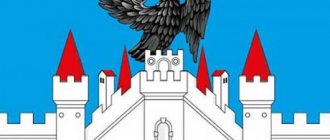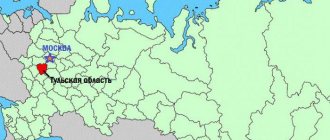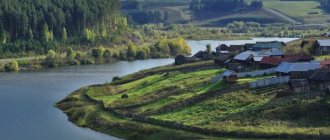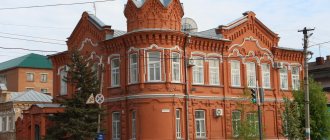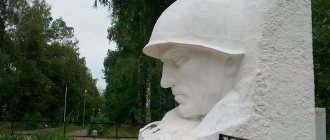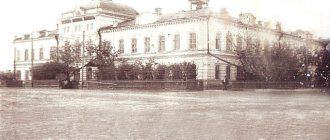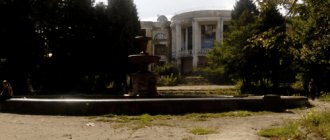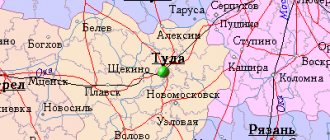Author: PPK
September 12, 2015 09:55
Tags: history facts
25062
22
The Tula region has an ancient and rich history. Being practically in the center of the Russian Plain, it has more than once become a field of clashes between states and tribes and the influence of ethnic groups. Once upon a time, the flows of settlement of Finno-Ugrians, Vyatichi Slavs and Balts converged on the territory of the Tula region.
0
See all photos in the gallery
In addition to its ancient history, the Tula region is rich in natural resources, represented by medicinal peats and mineral waters. The famous Tula abatis are also uniquely beautiful in these places - wide strips of deciduous forest that cross the territory of the region from west to east.
0
Very colorful landscapes are the river valleys: the upper reaches of the Don with its tributaries (Beautiful Mecha and Nepryadva) and the upper reaches of the Oka with its tributaries (Zusha, Osetr and Upa). The Tula land is a generous and beautiful region that has given Russia and the whole world talented artists, inventors, writers, and scientists.
×
0
Tula Kremlin
Pyatnitsky Gate Tower on the territory of the Tula Kremlin, Tula.
Photo: Elena Koromyslova / photobank “Lori” The wooden Kremlin in Tula was founded in 1507. Unlike other Russian defensive fortifications, they decided to build it on the low bank of the Upa River. The Kremlin was surrounded on all sides by natural barriers - swamps and rivers.
Construction was completed in 1509. And five years later, by order of Prince Vasily III, they began to build a stone one inside the wooden fortress - following the example of the Moscow Kremlin. The lower part of the walls was made of limestone, which was mined in the vicinity of Tula. The upper one, as in Moscow, was made of red brick. All walls and towers were decorated with battlements. Construction of the Tula Kremlin ended in 1520. In the 16th century, the fortress withstood sieges more than once, but never surrendered to the enemy.
After the reunification of Left Bank Ukraine with Russia in 1653, Tula ceased to be the southern outskirts of the state. The Kremlin was no longer used as a military fortress, and by the middle of the 18th century the oak walls were dismantled.
In 1762, the Assumption Cathedral was built on the territory of the fortress - the first stone church inside the Kremlin. In 1855, the Epiphany Cathedral was erected there.
During the Soviet years, the Kremlin was reconstructed several times, and in the late 1970s the Tula State Weapons Museum moved here. The exposition was placed in the Epiphany Cathedral.
In 2021, a Museum and Exhibition Complex with multimedia exhibitions was opened on the territory of the Kremlin. Today the Tula Kremlin is one of the most visited museum complexes in the country.
And the stone horse lies there...
When listing the beautiful natural places of the Tula region, one cannot ignore one more attraction - the megalith located in the village of Kozye. A huge boulder stands on several smaller stones, as if on a pedestal. Some say that this megalith was a landmark for launching merchant ships sailing to Istanbul or Crimea, others say that it is a monument to the victory of the Russian army over the Tatar-Mongol warriors.
The most interesting version is this: once upon a time a hero died here in an unequal battle. His faithful horse could not survive the loss and became petrified with grief. History is silent about how it really happened. But, according to legend, the megalith has healing powers. A man who sits on it will gain new sexual powers, and a woman will be able to bear and give birth to a child.
Kulikovo field
Obelisk to Dmitry Donskoy on the Red Hill of Kulikovo Field, Tula region. Photo: Natalya Ilyukhina / photobank “Lori”
On the territory of the Tula region, on the banks of the Don River, there is the Kulikovo Field - the place where on September 8, 1380, a battle took place between the Moscow prince Dmitry I Ivanovich and the Golden Horde commander Mamai. For his victory in the Battle of Kulikovo, Dmitry I received the nickname Donskoy.
It was decided to create a museum on Kulikovo Field only in the 19th century. It was proposed by historian and amateur archaeologist Stepan Nechaev to open it. In his Polibino estate in the Ryazan province (now Lipetsk region), Nechaev opened the first museum of the Battle of Kulikovo. In it he placed sabers, chain mail, spear and arrowheads and other archaeological finds.
In 1850, an obelisk was installed on the Red Hill of Kulikovo Field - a black cast-iron column with a golden dome and a cross. The project was prepared by the artist and architect Alexander Bryullov. And at the beginning of the 20th century, the Temple of Sergius of Radonezh was erected here. According to legend, it was this saint who blessed Dmitry Donskoy for the battle. The design of the temple was created by Moscow architect Alexei Shchusev. The building is reminiscent of Russian pre-Petrine churches, and one of the domes repeats the shape of military helmets of the 14th century.
During the Great Patriotic War, the obelisk was destroyed, and the icons and iconostasis were removed from the temple. Restoration of the complex began in the 1960s, and in 1996 a museum-reserve was created here. Its exposition is located not only in the complex on the Kulikovo Field itself, but also in other branches - in the village of Monastyrshchino, the village of Epifan. Permanent exhibitions are dedicated to the history of the Kulikovo Field, as well as the Battle of Borodino, Prokhorovsky and other major battles in Russian history.
Quarries on the Sturgeon River
Byakovsky, or, in other words, Guryevsky, quarries are separate systems of underground passages stretching for a distance of 70 to 150 km along the bank of the Sturgeon River. Back in the 15th and 16th centuries, limestone was mined here by prisoners. But the stone turned out to be of poor quality, so the mine was closed. A cave less than 1 km long appeared in that place. In 1946, it was filled up, but a man who remained unknown cut a “window” into the quarry by simply digging a ventilation hole. Since then, there have been a lot of people in this beautiful place in the Tula region.
Museum-estate of L.N. Tolstoy "Yasnaya Polyana"
Museum-estate of the writer Leo Tolstoy “Yasnaya Polyana”, Tula region. Photo: Pukhov K. / photobank “Lori”
Yasnaya Polyana is the Tolstoy family estate, where the writer Leo Tolstoy was born in 1828. It was first mentioned in 1652 in the list of possessions of the local governor Grigory Kartsev.
In the middle of the 18th century, the Volkonsky princes, Tolstoy’s relatives on his mother’s side, bought this estate from the Kartsevs. The writer’s grandfather Nikolai Volkonsky began building a manor house in Yasnaya Polyana. On his orders, a park was laid out here, ponds were dug and apple orchards were planted. While the estate was being built, the prince and his family lived in another building on the estate. Later there were housekeeping services and servants' rooms. Now this building is known as the Volkonsky House. This is the oldest surviving building in the museum ensemble.
During Nikolai Volkonsky’s lifetime, they did not have time to complete the manor’s house. Only the first floor and two wings were completed. The construction of the main house of the estate was completed by the prince’s daughter Maria Volkonskaya and her husband Nikolai Tolstoy, the writer’s parents.
In 1847, Yasnaya Polyana was inherited by Leo Tolstoy. A few years later, due to gambling debts, he sold the manor house. It was dismantled and taken to the neighboring Dolgoye estate. The building stood there until the beginning of the 20th century. In 1913 it was dismantled due to its disrepair. In Yasnaya Polyana, only a stone remained from the foundation of the building, on which in Soviet times the inscription “Here stood the house in which L.N. was born” was knocked out. Tolstoy."
Since 1921, there has been a museum-reserve here, which today is run by the writer’s descendants. The main exhibition today is located in one of the wings. It includes personal belongings of the writer and his family, a library of 22 thousand books, and family portraits.
Ishutinskoye settlement
An amazingly beautiful place in the Tula region for walking by car. It is covered with many different myths and legends. They say that a long time ago there was a city here, which the Crimean Tatars were never able to take. It’s just that when they arrived, people disappeared somewhere, leaving behind only glowing coals in the stoves, and this happened repeatedly. It is worth noting that the answer has not yet been received. No secret caves where city residents could go have yet been discovered. The settlement is washed by a river with a stunning name - the Beautiful Sword.
Nikolo-Zaretsky Church in Tula
Nikolo-Zaretsky Church, Tula. Photo: Denis Larkin / photobank “Lori”
In the 17th century, on the site of the current Nikolo-Zaretsky Church there were two wooden churches. Next to them was the family tomb of the Demidov industrialists, owners of weapons and metallurgical factories.
The construction of a stone cathedral on the site of wooden churches began in 1729 at the expense of Akinfiy Demidov. The temple was built in the Peter the Great Baroque style, with a stucco cornice.
In 1730, the newly erected bell tower of the temple collapsed. A new one was built on the opposite side of Nikolsky (now Oruzheyny) Lane. It was connected to the temple by a metal suspended gallery with an openwork lattice.
In 1779, due to a fire in the Nikolo-Zaretsky Church, the gallery, roof, and dome of the church were damaged. Representatives of the famous Tula families - the Demidovs, Batashevs, and Lyalins - donated money for the restoration. The restored temple was consecrated in 1803.
In the 19th century, the temple was restored and rebuilt several times, but no major changes were made to its layout. In 1914, a wrought iron fence on a white stone plinth was erected around the church.
Divine services in the Nikolo-Zaretsky Church were held until 1934. In Soviet times, the church housed a granary and warehouse, and the Demidovs’ tomb housed apartments.
Restoration of the temple began only in the late 1970s. However, due to a mistake by the builders, almost all of the stucco decoration of the facade was lost. It remained only on the northern wall of the temple. In the 1990s, the Nikolo-Zaretsky Church was transferred to the church. And a museum was opened in the Demidov necropolis.
The abandoned estate of the von Meck family
The estate located in Khruslovka once belonged to the king of the Russian railway, Karl von Meck. And although the entrepreneur himself was practically forgotten, his wife will forever remain in history. After all, one of P. I. Tchaikovsky’s works was written in her honor. Despite the fact that the estate survived the revolution, it is now in terrible condition. However, this does not make it any less beautiful and grandiose.
All Saints Cathedral in Tula
All Saints Cathedral, Tula. Photo: Boris Breytman / photobank “Lori”
The wooden All Saints Church in Tula appeared in 1773. It was laid in the “plague” cemetery, where those killed during the plague epidemic in 1771–1773 were buried. In 1776, a spacious stone church began to be built on the site of the wooden church.
It was built in several stages. First, the lower church was consecrated in honor of All Saints, and in the late 1780s, at the expense of the Tula merchant Nikifor Devyatkin, the upper one, the Church of the Transfiguration of the Lord, was completed.
In 1790, during the liturgy, one of the five domes of the temple collapsed. Several parishioners died, and the Church of the Transfiguration was closed for five years. The reconstruction of the destroyed part ended in 1797, and the temple was reconsecrated only in 1825.
In 1863, a three-tier bell tower was built next to the church according to the design of Carl Rossi’s student Vasily Fedoseev. It reached a height of 82 meters - higher than the Spasskaya Tower of the Moscow Kremlin.
From 1923 to 1944, the All Saints Church was the main temple of the Tula Renovationists, a schismatic movement of the Russian Orthodox Church. Since 1945, the temple has become the cathedral of Tula. It was restored in the 1990s.
Armored train "Kozma Minin"
Visiting the beautiful places of Tula and the Tula region and not visiting the Chern railway station is a big omission. After all, here you can touch the history itself - see a real armored train, which at one time was an example of armored vehicles. It is installed on the site where the commanders of the 31st special Gorky division once died.
Interesting places in Belev
A small town in the center of the region, with a population of no more than 15,000 people, is always happy to welcome tourists. Located 115 km from Tula. You can get to Belev by bus or car. The first mentions of the city date back to the 12th century. It is mentioned in the same chronicles as Moscow, because... these cities were founded around the same time.
Belev is famous among other cities in the region for the fact that it produces extremely tasty marshmallows. This is what they bring as a delicious gift from this city. The first mention of the production of sweets dates back to 1890. The famous merchant Prokhorov began its wide production. Thanks to him, such marshmallows are still produced in Belevo to this day. The peculiarity of this sweet is that it is made from local apples. The Antonovka variety in Belev is very tasty and juicy, which is why this marshmallow is so special and Belev is the city where to go for it.
In Belev they make lace, which has no analogues in the whole world. They are woven on so-called bobbins - wooden spools with threads attached to the ends. Usually monochromatic threads are used, but multi-colored weaving can also be found.
There are architectural monuments in Belevo. There are 2 temples in the city, but both of them are under renovation and tourists do not have access to them. There is a local history museum in Belevo, which contains a historical summary of all periods in the development of the city. There are many different paintings and sculptures here.
Interesting places in Belev
